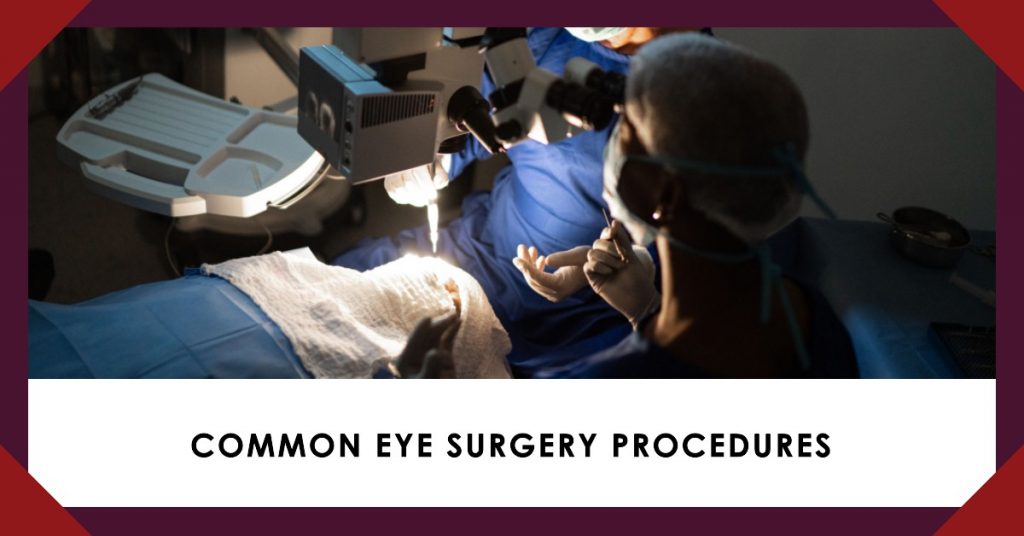
Eye surgery, also known as ocular surgery, is a medical procedure involving surgical operation on the eye and its surrounding area. This type of surgery is often done to correct vision problems, treat injuries or diseases affecting the eyes, or restore the appearance of the eyes.
Common eye surgeries include:
- blepharoplasty
- cataract surgery
- corneal transplantation
- glaucoma surgeries
- LASIK/PRK refractive procedures
- retina surgeries
- eye muscle surgeries
Each type of eye surgery has its own purpose and carries different risks and benefits depending on the patient’s health history. It is important for patients to understand all possible risks before undergoing any form of eye surgery.
The following article will discuss common types of eye surgeries and what to expect from them.
Blepharoplasty
Blepharoplasty is a cosmetic surgical procedure which aims to improve the appearance of the eyelids. It can address issues caused by excess skin, age related changes, or blockage of the tear ducts. Eyelid drooping can also be corrected through this procedure.
The surgery typically involves making incisions near the lash line and removing any excess fat or tissue that may be causing these various problems. In some cases, Blepharoplasty may also involve tightening or repositioning of muscles around the eyes in order to reduce wrinkles and sagging skin.
This muscle tightening can give a more youthful appearance to the eyes while still allowing for natural movement when blinking or smiling. In addition, many patients report improved vision after undergoing Blepharoplasty due to improved peripheral vision caused by removal of excess skin from their eyelids.
The recovery time following Blepharoplasty varies depending on individual factors such as age and health status but typically takes between one to two weeks before any signs of swelling have subsided and full results are seen. Patients should avoid strenuous activities during this period in order to ensure a successful recovery process with minimal risks of complications.
Cataract Surgery
Cataract surgery is a vision correction procedure that involves the removal of the clouded lens of the eye and its replacement with an artificial one.
Cataracts are usually diagnosed through a comprehensive eye exam, where the ophthalmologist will evaluate the patient’s visual acuity and look for any signs of cataracts using specialized equipment.
The cost of cataract surgery varies depending on factors such as severity, technology used, geographic location, and insurance coverage; however, it is generally considered to be an affordable procedure.
Post-surgery recovery time can range from 1-2 weeks and common complications include infection or inflammation in response to the new lens. Alternative treatments may include medication or lifestyle changes such as wearing eyeglasses or sunglasses outdoors.
Although cataract surgery provides relief from blurred vision and impaired sight associated with cataracts, it is important to understand all aspects of this procedure before deciding whether or not to have it done.
Consulting your doctor about potential risks and benefits can help you make an informed decision.
Corneal Transplant
Corneal transplantation is a surgical procedure involving the replacement of corneal tissue in order to restore vision and improve ocular health. It is typically performed when the cornea has been damaged due to disease or injury, or if it is not able to refract light properly.
The procedure involves removing either all or part of the damaged cornea, and replacing it with donor tissue from a compatible donor. After the transplant surgery, post op care is important for proper healing and to reduce the possibility of rejection. This includes using eye drops and attending follow-up appointments to monitor progress.
Corneal healing can take several months after a transplant surgery before visual recovery becomes noticeable. The degree of visual recovery varies depending on pre-existing conditions such as glaucoma or macular degeneration that may be present in addition to factors related to donor compatibility, such as age of donor tissue and exposure time prior to implantation.
In these cases, multiple surgeries may be required in order for there to be any improvement in vision. Patients should discuss their expectations regarding visual recovery with their doctor before undergoing corneal transplantation since there are no guarantees that vision will return completely after this type of procedure.
Post op care is also essential in order for any potential improvement in eyesight resulting from this type of surgery by reducing the risk of complications associated with rejection or infection.
Glaucoma Surgeries
Glaucoma is an ocular condition that can lead to blindness if left untreated, and various surgical procedures are available to treat it. Risk factors for developing glaucoma include age, family history, prior eye injury or inflammation, certain medications or medical conditions, and race. Screening tests such as a visual field test or optic nerve imaging can help diagnose glaucoma. Prevention strategies include regular comprehensive eye exams and monitoring of intraocular pressure (IOP).
The most common type of surgery for glaucoma is a laser trabeculoplasty (ALT/SLT), which helps reduce IOP by improving the outflow of fluid from the eyeball. This procedure takes around 15 minutes and is usually done in an outpatient setting without general anesthesia. Other types of surgeries used to treat glaucoma may involve creating a new drainage channel in the eye (trabeculectomy) or implanting a device into the eyeball to help drain fluid (shunt surgery). Medication side effects such as headaches, dizziness or nausea can also occur with some treatments for glaucoma.
Surgery should be considered after other forms of treatment have been attempted since there are risks associated with any invasive procedure. Surgery has potential complications including infection, increased IOP levels requiring additional medication or surgery, scarring on the cornea which may affect vision quality long-term, and loss of vision if proper care is not taken before and after the procedure. For these reasons it’s important to talk with your doctor about all available treatment options so you can make informed decisions about your health care needs.
LASIK/PRK
Laser-Assisted In Situ Keratomileusis (LASIK) and Photorefractive Keratectomy (PRK) are refractive surgeries that reshape the cornea to correct vision problems such as nearsightedness, farsightedness, or astigmatism. LASIK and PRK are two of the most popular laser treatments used in eye surgery to correct refractive errors.
The primary difference between LASIK and PRK is that during LASIK, a thin flap is created in the outer layer of the cornea before the laser treatment begins while during PRK, no flap is created. During both procedures, the excimer laser removes tissue from the cornea according to a unique pattern designed for each individual patient’s eyes in order to correct their vision problem. The other difference is the cost. The lasik eye surgery price varies depending on the clinic and the specific requirements of the patient and is comparatively a bit expensive than PRK.
After completion of either procedure, patients may experience some eye fatigue or strain due to their body adjusting to its new shape. However, after this adjustment period passes, most people with nearsightedness will be able to see without glasses or contact lenses at all distances. Patients with farsightedness will often need glasses for up-close tasks but may also have improved distance vision without corrective eyewear.
Astigmatism can also be corrected with either procedure allowing patients greater clarity when viewing distant objects or reading small print.
In summary, LASIK and PRK provide an effective method of correcting refractive error by using laser treatments which reshape one’s cornea over time. Post-surgery recovery periods vary depending on individual cases however results tend to last many years with proper care and maintenance of one’s eyes through regular visits with an ophthalmologist or optometrist.
Both procedures offer potential for reducing dependence on glasses or contact lenses along with a reduction in associated eye fatigue or strain thus providing significant improvements in quality of life and overall eye health for those who choose these surgeries as viable alternatives for vision correction.
Retina Surgeries
Moving on from LASIK/PRK, retina surgeries are another type of eye surgery to consider. There are a number of age related and other conditions that can affect the retina and require surgical intervention.
The most common retina surgeries include:
- Diabetic retinopathy treatment – This procedure is used to treat diabetic retinopathy, which is caused by damage to the blood vessels in the retina due to diabetes. It involves using laser therapy or surgery such as vitrectomy to remove damaged tissue and restore vision.
- Laser retinal surgery – A laser may be used during a variety of different procedures, including macular degeneration treatment, glaucoma treatment, and diabetic retinopathy treatment. The laser is used to destroy abnormal blood vessels or scar tissue in order to improve vision.
- Vitreoretinal surgery – This type of procedure is done when there are abnormalities in the vitreous humor (the clear gel-like substance that fills the back chamber of the eye). During this procedure, doctors use microscopic instruments to perform delicate operations inside the eye such as removing scar tissue or repairing a detached retina.
- Retinal detachment repair – Retinal detachments can occur due to aging changes in the eye or trauma from an injury or accident and requires immediate surgical repair in order for vision to be restored properly. During this procedure, doctors will seal tears with lasers or cryotherapy (freezing) and then reattach any detaching areas of the retina using tiny sutures inside the eye cavity if needed.
Retina surgeries tend to have good long term outcomes when performed correctly by experienced surgeons with access to modern equipment and technology; however, it’s important for patients considering any kind of eye surgery understand all risks associated with these procedures beforehand so they can make an informed decision about their care plan moving forward.
Eye Muscle Surgery
Eye muscle surgery is a specialized ophthalmological procedure used to correct strabismus, or misalignment of the eyes, by altering the position of muscles that control eye movement. This type of corrective surgery is sometimes recommended after it has been determined that vision therapy and/or laser therapy cannot sufficiently improve ocular alignment.
The goal of this surgical intervention is to restore normal binocular vision and prevent eye fatigue caused by excessive use of one eye while looking at objects.
During an eye muscle surgery procedure, the surgeon may move, shorten, or remove extra tissue from one or more muscles in order to adjust their positions and create greater balance between them. In addition, some surgeries make use of sutures which can be adjusted post-operatively in order to fine tune strabismus correction if necessary.
While there are risks associated with any kind of surgical procedure, these types of surgeries have become very safe due to advances in technology and experience gained over time.
Patients should expect a period of recovery after undergoing an eye muscle surgery during which they may need patching or glasses for best possible results. Most patients will notice improved vision shortly after the conclusion of the procedure but full healing may take several weeks or months depending on individual circumstances.
Conclusion
Eye surgery is a common type of medical procedure that can be used to treat many different eye conditions and diseases. While the specific procedures may vary, the overall goal of each surgery is to improve vision or reduce discomfort associated with a condition.
The most common eye surgeries include blepharoplasty, cataract surgery, corneal transplant, glaucoma surgeries, LASIK/PRK, retina surgeries and eye muscle surgery. Each of these procedures have their own unique risks and benefits that must be weighed before deciding if an individual should proceed with the operation.
Furthermore, it is important for patients to understand what will take place during the operation in order to prepare accordingly and ensure a successful outcome.
In conclusion, while there are many potential risks associated with any type of surgical procedure, understanding the various options available as well as preparing adequately for whatever form of eye surgery one chooses can help reduce potential complications and increase the likelihood of successful results.







